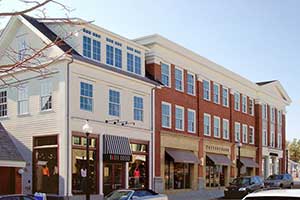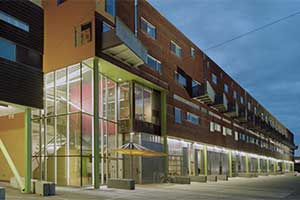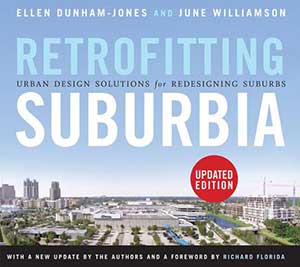Cars are king in most Michigan suburbs. We have designed our suburbs for efficiency of process, where uses are separated and car-oriented, said Ellen Dunham-Jones, co-author of Retrofitting Suburbia, at the League’s Suburban Summits in May. But in recent years, suburbs have been hit with a double-punch from the struggling economy and changing demographics, leaving them with empty buildings and properties in need of a new life.
That’s a game-changer, says Dunham-Jones, making efficiency of place the watchword of the day as we consider how to redevelop our suburbs. The efficiency of more compact, urban development can provide cities with lower infrastructure costs and higher tax revenue per acre. At the same time, it offers millennials and baby boomers the walkable, urban lifestyle they crave.
As suburbs consider how to retrofit underutilized properties, Dunham-Jones emphasizes first knowing why the site died. That will help determine which of the following design strategies is the most appropriate, although many older retrofits have some degree of all three strategies:
- Reinhabit – use the building for a more community-service purpose
- Redevelop – build a more dense, urban, walkable place
- Regreen – turn the site into a park or open space
For more details on these three strategies, please read an earlier blog, “Creating a Purposeful New Life for Old Suburban Sites”.
21st Century Challenges
Retrofitting can also help suburbs address a variety of 21st century challenges – everything from auto-dependence and jobs to an aging population and environmental issues.
Auto-dependence

Public Health
The sedentary lifestyle of the suburbs has contributed to an epidemic of chronic diseases, such as obesity, diabetes, and heart disease. Human sprawl and suburban sprawl correlate, says Dunham-Jones. People in urban areas tend to lead more active lifestyles, so she advises introducing more physical activity and walkability and making streets safer. One example she offered is the dying One Hundred Oaks Mall in Nashville, Tennessee. Vanderbilt University took over the second floor of the mall for a medical center. The center is getting better patient results as people love the convenient location and the chance to shop while waiting for their appointment.
Social Capital
Suburban social life used to revolve around schools, but with a rising number of childless households, people are seeking new “third” places when they can build community. A group in Oak Cliff, Texas came up with a creative solution to that challenge along a boarded-up block of businesses. For two days, the Build a Better Block group transformed the block with art in the store windows, street trees, food trucks and more. Two small ordinance changes from the city enabled some of these changes to become permanent.
Equity and Affordability
Transportation costs are higher in the suburbs, particularly for people in the lower half of the income bracket. They often spend more on transportation than housing, so affordable housing near affordable transportation is essential. At Cottages on Greene Street in Rhode Island, the answer to affordable housing came in the form of dense, quaint cottages that seamlessly transition into the surrounding commercial area.
Jobs

Energy
As energy costs escalate, energy conservation becomes a bigger concern. At the Mueller development in Austin, Texas, a former airport is being developed into an urban community where all the houses are on a smart grid and use solar power.
Water
Water can be a challenge on several fronts – your community may have too much, too little, or the quality has been compromised. At Northgate Urban Center in North Seattle, Washington, the mayor was able to improve water quality by negotiating a deal that enabled daylighting a creek that had been routed through a pipe. The creek is now an amenity for the new condos and senior housing that surrounds it.
As with the three design strategies for retrofitting suburbs, we need layered solutions to deal with all the 21st century challenges as well, says Dunham-Jones. We need to change the metrics of success.
